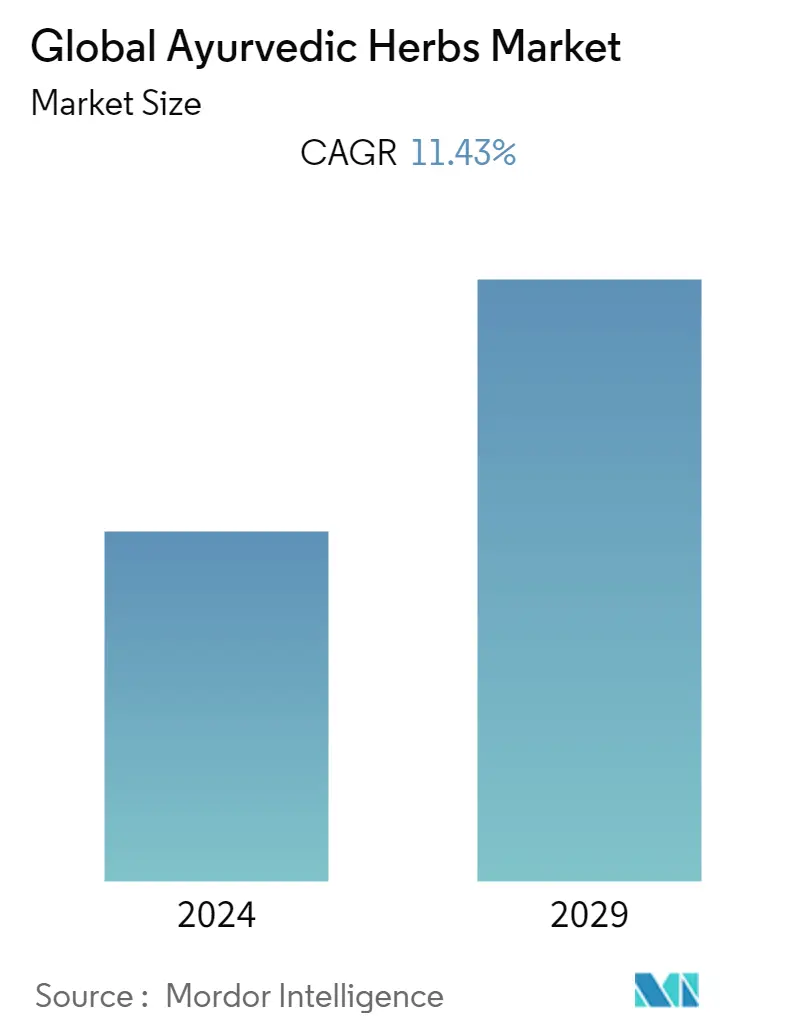Market Size of Global Ayurvedic Herbs Industry

| Study Period | 2019 - 2029 |
| Base Year For Estimation | 2023 |
| Forecast Data Period | 2024 - 2029 |
| CAGR | 11.43 % |
| Fastest Growing Market | Europe |
| Largest Market | Asia-Pacific |
Major Players
*Disclaimer: Major Players sorted in no particular order |
Need a report that reflects how COVID-19 has impacted this market and its growth?
Ayurvedic Herbs Market Analysis
The ayurvedic herbs market is expected to register a CAGR of 11.43% during the forecast period (2022-2027).
Since the beginning of 2020, the Covid-19 pandemic have changed the healthcare system as well as affected the lifestyle of population worldwide. People were stuck indoors for months. During the isolation target population opt for home remedies and natural food supplement. This led people to follow a 5000-year-old history of Ayurveda. To boost immunity and find ways to live a healthy and safe lifestyle people opted for Ayurvedic treatments and remedies. This has impacted the studied market growth positively. The steps taken by governments have fueled the use of Ayurvedic herbs as preventive measure against Covid-19 infection driving the growth of the studied market. For instance, in October 2020, Ministry of AYUSH (Ayurveda, Yoga, Naturopathy, Unani, Siddha, and Homoeopathy), Government of India released the 'National Clinical Management Protocol based on Ayurveda and Yoga for the management of Covid-19'. In this protocol under the Ayurveda for management of Covid-19 section they have mentioned several use ways of using herbs to prevent the SARS-CoV2 infection. The above protocol suggested to gargle with warm water added with a pinch of turmeric and salt, or to gargle with water boiled with Triphala (dried fruits of Emblica oficinalis, Terminalia chebula,Terminalia bellerica) or Yashtimadhu (Glycyrrhiza glabra). The Nasal instillation of medicated oil (Anu taila or Shadbindu Taila) or plain oil (Sesame or Coconut) or nasal application of cow's ghee (Goghrita) once or twice in a day was suggested to prevent the Covid-19 infection.
Additionally, an article published in October 2020 titled 'A review on exploring the siddha and ayurvedic medicines for covid-19 infection' mentioned that Covid19 has occurred in different types like mild respiratory illness (nose, throat, and lungs), severe acute respiratory syndrome (SARS), and Middle East respiratory syndrome (MERS) and several studies have been done on curative effects of Ayurvedic and other traditional medicines on these various diseases. This above-mentioned article concluded that, Siddha and Ayurvedic medicines have mitigated COVID-19 infections in many cases. Hence, owing to the above-mentioned factors and research, the demand for ayurvedic herbs have increased, driving the growth of the studied market during the Covid-19 pandemic.
Furthermore, factors such as rising burden of chronic diseases globally, and awareness on the side-effects of other medicines is further driving the consumer preference for ayurvedic products, benefiting the studied market. Increasing popularity of natural and organic medicines and their benefits among the consumers also act as a driving factor for the growth of the studied market.
There is an increasing popularity and surging demand of ayurvedic products for several other applications including skin care, hair care, oral care among consumers. Along with government initiatives, this surging demand is driving an increasing number of market players to innovate and develop new products. Hence, boost the growth of the studied market. For instance, in May 2021, Ministry of AYUSH (Ayurveda, Yoga, Naturopathy, Unani, Siddha, and Homoeopathy), India has launched a massive nationwide campaign to distribute its polyherbal ayurvedic drugs AYUSH 64 and Sidha drug Kabasura Kudineer for COVID-19 patients that have not been hospitalized. The efficacy of these two drugs has been proven through strong multi-center clinical trials says the Ministry of AYUSH (Ayurveda, Yoga, Naturopathy, Unani, Siddha, and Homoeopathy).
In addition, Dabur India Ltd. entered the Health Food Drink category with the launch of 'Dabur Vita' in December 2021. Dabur Vita is made with a unique blend of more than 30 herbs such as Ashwagandha, Giloy and Brahmi, which are scientifically proven to provide better immunity as well as to promote physical and mental growth among kids.
Furthermore, an article published in July 2021 titled 'Ayurveda recognized as a system of medicine in 16 countries', by Organiser.org shows that, Ayurveda is recognized as a System of Medicine in Nepal, Sri Lanka, Pakistan, Bangladesh, United Arab Emirates (UAE), Oman, Saudi Arabia, Bahrain, Malaysia, Mauritius, Hungary, Serbia, Tanzania, Switzerland, Cuba, and Brazil. While Romania, Hungary, Latvia, Serbia, and Slovenia are five countries of the European Union (EU), where Ayurvedic practices is regulated. Similarly, several other countries have also incorporated Ayurvedic herbs as systems. According to the similar source, AYUSH (Ayurveda, Yoga, Naturopathy, Unani, Siddha, and Homoeopathy) products are exported to more than 100 foreign countries either as Medicine or as Food supplements.
Therefore, owing to the aforesaid factors the global ayurvedic herbs market is gaining demand globally and is expected to grow over the forecast period.
